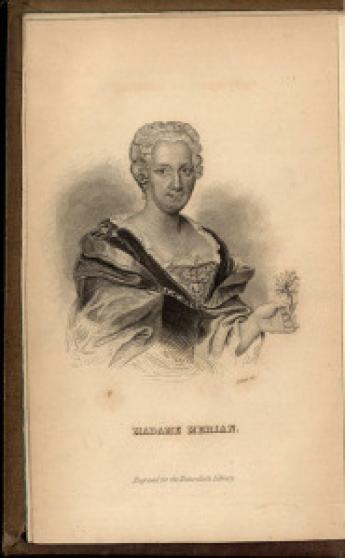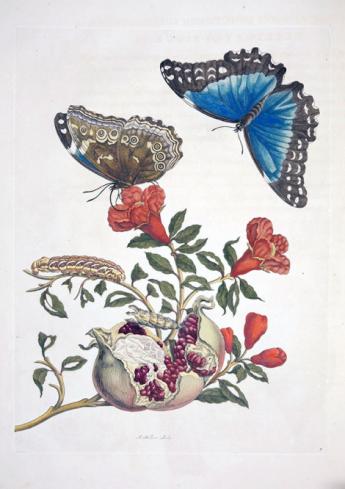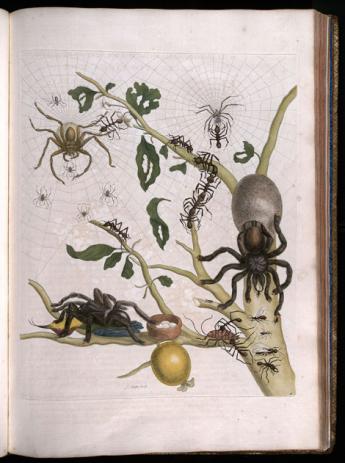To all Lovers and Investigators of Nature: Maria Sibylla Merian; 1647-1717

2017 marks the 300th anniversary of the death of the German artist and entomologist Maria Sibylla Merian, one of the most celebrated natural scientists of her time. From an early age she pursued a fascination with the insect life cycle, then only partially understood. Merian was the first to bring together insects and their habitats and the knowledge she collected provided important insights into medicine and science.
(Note by the editor: Maria Sibylla Merian was a German-born naturalist and scientific illustrator, a descendant of the Frankfurt branch of the Swiss Merian family, founders of one of Europe's largest publishing houses in the 17th century.)
Maria Sibylla Merian was brought up in Protestant Frankfurt, the youngest daughter of Matthäus Merian, a Swiss-born printmaker and draughtsman. Matthäus owned a flourishing publishing house that specialised in lavishly illustrated books. Following his death in 1650, Merian’s mother married still-life painter Jacob Marrell who encouraged his stepdaughter’s talent. As a young girl Maria Sibylla Merian painted flowers, before becoming obsessed with caterpillars and how they metamorphosed into moths and butterflies.
Her interest in insects was stimulated by the practice of silkworm breeding that had been introduced by the silk trade in Frankfurt. She began to study caterpillars and would breed her own insects, collecting local caterpillars and observing their metamorphoses. She combined her skill as a flower painter with her scientific investigations, publishing studies of caterpillars. She had a deep reverence for nature, and saw the hand of God in the perfection of natural forms.
Merian married Andreas Graff – one of her stepfather’s pupils – when she was 16 and moved with him to his native Nuremberg, where she taught painting and embroidery. Their house was filled with boxes, jars, and plants. In 1679, a year after the birth of her second daughter, Merian published "Der Raupen wunderbarer Verwandlung" (The Wondrous Transformation of Caterpillars), the result of almost two decades of observations.
In 1685, Merian ran away from her husband and took her mother and daughters to West Friesland in the Dutch Republic to to join a religious community at Waltha Castle. When Graff pursued her and appealed to her to return, the sect declared she was free from all marital obligations to a nonbeliever. She re-established herself in Amsterdam, where she ran her own shop and educated her daughters, Dorothea and Johanna, also talented artists.
Merian developed an interest in the exotic insects which were brought to the city, particularly those from Suriname, a Dutch colony to the north of Brazil. In 1699 she undertook the journey to Suriname with Dorothea, to study insects in their natural habitat. She financed her adventure by selling her drawings and collected whatever she could. She questioned indigenous people and paid them to bring her insects. They hacked paths into the jungle for her so that she could scramble through the tangle in corset and petticoat.
The resulting lavish publication, Metamorphosis Insectorum Surinamensium (The Metamorphosis of the Insects of Suriname) was published in Latin and Dutch in 1705 and reissued in 1719, 1726, 1730 and 1771. The book included 60 large plates, each with an accompanying description. Life-size studies capture the insects of Suriname and the plants that sustained them. Merian etched the designs onto the plates herself then passed them to professional printmakers to be engraved for publication.
Metamorphosis Insectorum Surinamensium influenced many subsequent works of natural history. Merian corresponded with scientists across Europe. The Swedish naturalist Carl Linnaeus used her drawings to classify insects, and Goethe praised Merian for her ability to move “between art and science, between nature observation and artistic intention”. The research Merian undertook in Suriname brought the wonder of South American wildlife to Europe and changed the course of natural history illustration.
The Library’s copy of the 1705 edition of Metamorphosis Insectorum Surinamensium was accessioned in 1951. The volumes have recently received essential conservation work to ensure that the books are preserved and safeguarded for future generations to study and enjoy.
‘Maria Merian’s Butterflies’ at the Queen’s Gallery, Palace of Holyroodhouse, Edinburgh, tells the artist’s story through her works acquired by George III and now in the Royal Collection. These include the luxury versions of the plates from the Metamorphosis, partially printed and then hand-painted on vellum by Merian herself. (more info, see below)
This article was first published on ECHOES FROM THE VAULT, a blog from the Special Collections of the University of St Andrews, and is published here with the permission of the author, Gabriel Sewell, Head of Special Collections and Assistant Director of Library Services.
The NEW YORK TIMES recently published an article on Maria Sybilla Merian - you find the link here.
To visit the Merian exhibition "Maria Merian's butterflies", please visit the website
Exhibition runs from 17 March - 23 July 2017 at the Queen's Gallery at the Palace of Holyroodhouse, Edinburgh.
Image descriptions:
Image 1: Maria Sibylla Merian from James Duncan, The Natural History of British Moths, Sphinxes, &c. (Edinburgh, 1841)
Image 2: Plate depicting a branch of Pomegranate with the Menelaus Blue Morpho butterfly and the caterpillar of the Banded Sphinx moth.
Image 3: The depiction of the tarantula attacking the hummingbird continues to generate debate and may be the basis for the belief that these spiders eat birds.



